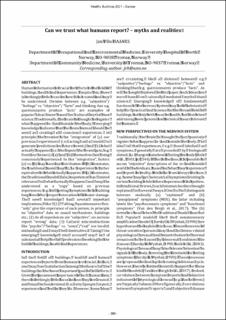| dc.description.abstract | Human information is crucial for efforts in the field of buildings, health and experiences. Despite this, there is strikingly little focus on how it is created and may be understood. Division between e.g. “subjective”/ “feelings” vs. “objective”/ “facts” and thinking that e.g. questionnaires produce “facts” are examples of popular ideas more based on cultural myths than science. Traditionally, the brain is thought to register what happens in- and outside the body. Emerging knowledge indicates that the brain instead should be seen as creating all conscious experiences. In principle, the creation is an “integration” of (a) our previous experiences (i.e. acting as a model to generate predictions on future events) and (b) what actually happens (i.e. the inputs the brain gets, e.g. from our senses); (a) and (b) themselves not being consciously experienced. In this “integration”, factors (a) vs. (b) may have any distribution. If (b) dominates, the traditional model may fit, i.e. experience is rather equivalent to what actually happens. If (a) dominates, the traditional model fails, experience has limited relevance to what actually happens and may be understood as a “copy” based on previous experiences; e.g. still getting symptoms in a building long time after proper renovation of a water-damage. The new knowledge has several important implications, like: (1) Talking, questionnaires etc. “only” give the experience of each person, in principle no “objective” data on causal mechanisms, buildings etc.; (2) As all experiences are “subjective”, no persons report “wrong” data; (3) Cultural misconstructions like “psyche”/“feelings” vs. “soma”/“real” are invalid, misleading and may be destructive. Taking the emerging knowledge into account may be of substantial help for all professions working in the field of buildings, health and experiences. | |

